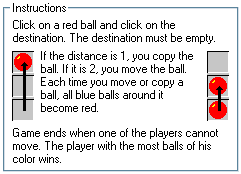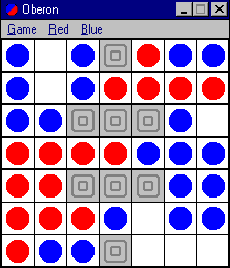Rules and parameters

These rules and parameters were established by myself in april and july 1997, after studying existing Ataxx games.
1) The essential elements
- The game is played on a squared board, divided in squares of same size.
- Two players confront each other, using pieces of different colours (one colour by player).
- Each player begins with two pieces, the 4 pieces are in the corners of the square.
- By using horizontal, vertical and diagonal moves, each piece may go in an adjacent free square, splitting in two pieces, or it may jump one case to go on a free square (without splitting).
In this illustration the initial position is green, the 8 destinations with twinning of the piece are yellow, and the 16 destinations by jump (the piece disappears from its initial position) are in grey.
- Each opponent piece adjacent to the destination square turns its colour (in horizontal, vertical and diagonal direction, until 8 pieces may so be touched).
- Players alternate turns, making one move each turn.
- You cannot "pass" or skip a turn, unless trapped.
- The winner is the one with more pieces when all the squares are filled. It may also finish before, when a player got 0 piece or cannot play anymore even in future moves (however, if one player has more than half the pieces, and may fill the free ones without "giving" an accessible free case to his opponent, the game may be finished at this moment).
2) The standard elements
- The board size is 7x7.
- The board colour is blank (or grey).
- The pieces colours are blue and red.
- Human plays against computer.
- Each player begins with 2 pieces, diametrically opposed.
- The computer has the blue pieces, at up-right and down-left. The human player has the red pieces (up-left and down-right), and he plays first
- Some random or chosen squares are grey (or black or coloured). They are called blocks and are symmetrically placed around the centre of the square.
3) Less usual elements
- Human-human confrontation is possible.
- Ability to choose (edit) the position of blocks.
- Ability to choose the beginning pieces.
- Ability to choose the colours of pieces (or sort of pieces).
- Victories and defeats statistics.
- Indication of destination squares for the pointed piece.
- Several levels for the computer player.
- Ability to redo a game (same blocks positions).
- Save and restore a game.
- Ability to undo.
4) Complementary elements
- At the end of a game, players may eternally redo the moving in same positions, without finishing the game. A Principe such as "The game is ending when somebody plays 3 times the same placing sequence, and the one who have the most pieces wins" would allow to avoid such situations, happily enough rare.
- The blocks number must be limited, to keep the game "good playable". The following rule may be token : the blocks number must be less than the playable pieces number, so less than 7 x 7 / 2 = 24.5, maximum 24, and also must keep the accessibility to all the playable cases (particularly, there are no blocks at the 4 corners).
- The blocks configurations are conformable to the Blocks-Configs codification.
Red plays and wins !

Illustrations : Ylian Ataxx help, Oberon


